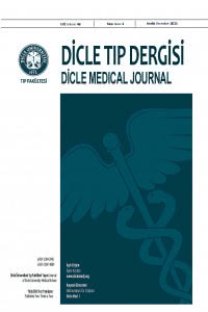Çocukluk Çağında Atipik Hemolitik Üremik Sendrom
Atypical Hemolytic Uremic Syndrome In Childhood
___
- Kaplan BS, Ruebner RL, Spinale JM, et al. Current treatment of atypical hemolytic uremic syndrome . Intractable & Rare Dis Res. 2014; 3: 34-45.
- Gasser C, Gautier E, Steck A, et al. Hemolytic-uremic syndrome: Bilateral necrosis of the renal cortex in acute acquired hemolytic anemia. Schweiz Med Wochenschr. 1955; 85: 905-909.
- Rosove M. Thrombotic microangiopathies. Semin Arth. and Rheum. 2014; 43: 797-805.
- Mannucci PM, Cugno M. The complex differential diagnosis between thrombotic thrombocytopenic purpura and the atypical hemolytic uremic syndrome: Laboratory weapons and their impact on treatment choice and monitoring Thromb Res. 2015; 136: 851-4.
- Canpolat N. Hemolytic uremic syndrome. Turk Pediatri Ars. 2015; 50: 73-82.
- Cataland SR, Wu HM. Atypical hemolytic uremic syndrome and thrombotic thrombocytopenic purpura: clinically differentiating the thrombotic microangiopathies. Eur J Intern Med. 2013 Sep;24: 486-91.
- Mannucci PM, Cugno M. The complex differential diagnosis between thrombotic thrombocytopenic purpura and the atypical hemolytic uremic syndrome: Laboratory weapons and their impact on treatment choice and monitoring. Thromb Res. 2015; 136: 851-4.
- Fremeaux-Bacchi V, Fakhouri F, Garnier A, et al. Genetics and outcome of atypical hemolytic uremic syndrome: a nationwide French series comparing children and adults. Clin J Am Soc Nephrol. 2013; 8: 554-62.
- Loirat C, Fakhouri F, Ariceta G, et al. An international consensus approach to the management of atypical hemolytic uremic syndrome in children. Pediatr Nephrol. 2016; 31: 15-39.
- Fakhouri F, Zuber J, Frémeaux-Bacchi V, et al. Haemolytic uraemic syndrome. Lancet. 2017; 390: 681-696.
- Picard C, Burtey S, Bornet C, et al. . Pathophysiology and treatment of typical and atypical hemolytic uremic syndrome. Pathol Biol. 2015; 63: 136-43.
- Nester CM, Thomas CP. Atypical hemolytic uremic syndrome: what is it, how is it diagnosed, and how is it treated? Hematology Am Soc Hematol Educ Program. 2012; 2012: 617-25.
- Kavanagh D, Goodship TH, Richards A. Atypical hemolytic uremic syndrome. Semin Nephrol. 2013; 33: 508-30.
- Le Quintrec M, Roumenina L, Noris M, et al. Atypical hemolytic uremic syndrome associated with mutations in complement regulator genes. Semin Thromb Hemost. 2010; 36: 641-52.
- Caprioli J, Noris M, Brioschi S, et al. Genetics of HUS: the impact of MCP, CFH, and IF mutations on clinical presentation, response to treatment, and outcome. Blood. 2006; 108: 1267-79.
- Durey MA, Blanc C, Garnier A, et al. Anti-factor H autoantibody-associated hemolytic uremic syndrome: review of literature of the autoimmune form of HUS. Semin Thromb Hemost. 2010; 36: 633-40.
- Nester CM, Barbour T, de Cordoba SR, et al. Atypical aHUS: State of the art. Mol Immunol. 2015; 67: 31-42.
- Loirat C, Frémeaux-Bacchi V. Atypical hemolytic uremic syndrome. Orphanet J Rare Dis. 2011; 8: 6:60.
- Noris M, Caprioli J, Bresin E, et al. Relative role of genetic complement abnormalities in sporadic and familial aHUS and their impact on clinical phenotype.Clin J Am Soc Nephrol. 2010; 5: 1844-59.
- Dixon BP, Gruppo RA. Atypical Hemolytic Uremic Syndrome. Pediatr Clin North Am. 2018; 65: 509-525.
- Sallée M, Ismail K, Fakhouri F, Vacher-Coponat H, et al. Thrombocytopenia is not mandatory to diagnose haemolytic and uremic syndrome. 2013; 8; 14:3.
- Çakar N, Ozcakar ZB, Ozaltin F , et al. Atypical Hemolytic Uremic Syndrome in Children Aged <2 Years. Nephron. 2018; 139: 211-218.
- Noris M, Galbusera M, Gastoldi S, et al .Dynamics of complement activation in aHUS and how to monitor eculizumab therapy.Blood. 2014; 124: 1715-26.
- Gruppo RA, Rother RP. Eculizumab for congenital atypical hemolytic-uremic syndrome. N Engl J Med. 2009; 360: 544-6.
- Licht C, Greenbaum LA, Muus P, et al. Efficacy and safety of eculizumab in atypical hemolytic uremic syndrome from 2-year extensions of phase 2 studies. Kidney Int. 2015; 87: 1061-73.
- Nishimura J, Yamamoto M, Hayashi S, et al. Genetic variants in C5 and poor response to eculizumab. N Engl J Med. 2014; 370: 632-9.
- Fidan K, Göknar N, Gülhan B et al, Extra-Renal manifestations of atypical hemolytic uremic syndrome in children. Pediatr Nephrol. 2018; 33: 1395-403.
- Cugno M, Gualtierotti R, Possenti I, et al. Complement functional tests for monitoring eculizumab treatment in patients with atypical hemolytic uremic syndrome. J Thromb Haemost. 2014; 12: 1440-8.
- Saland J. Liver-kidney transplantation to cure atypical HUS: still an option post-eculizumab? Pediatr Nephrol. 2014; 29: 329-32.
- ISSN: 1300-2945
- Yayın Aralığı: 4
- Başlangıç: 1963
- Yayıncı: Cahfer GÜLOĞLU
İnfertil Bir Erkekte “De La Chapelle” Sendromu: Olgu Sunumu
Muhammed Cihan TEMEL, Caner Ediz, Serkan AKAN, ÖMER YILMAZ
Adölesanlarda varyant anjina: Kardiyak bilgisayarlı tomografinin kullanımı ve literatür taraması
Hayrullah ALP, Esma Keleş ALP, Ahmet Midhat ELMACI
Kliniğimize Başvuran Mol Gebelik Olgularının Retrospektif İncelenmesi
MERT ULAŞ BARUT, Sibel SAK, Muhammet Erdal SAK
MEHMET CİHAN YAVAŞ, Veysi AKPOLAT, Engin DEVECİ, Hakkı Murat BİLGİN, İbrahim KAPLAN, Uğur ŞEKER, İsmail YILDIZ, Mehmet Esref ALKIŞ, Mustafa Salih ÇELİK, Mehmet Zülküf AKDAĞ
Prostat kanserinde miRNA aracılıklı ceRNA’ların biyobelirteç potansiyellerinin in siliko analizi
Mesut ENGİN, MEHMET TUĞRUL GÖNCÜ, Orhan GÜVENÇ, Muhammed SAVRAN, AHMET FATİH ÖZYAZICIOĞLU
Ekstrakraniyal ve intrakraniyal arter diseksiyonları: Bir üçüncü basamak merkezinden deneyimler
